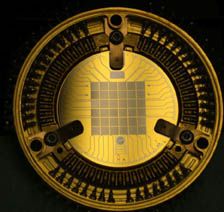X-ray Quantum Calorimeter (XQC)
Launch Date:
1995
The X-ray Quantum Calorimeter (XQC) is a broadband non-dispersive X-ray spectrometer built to study the diffuse soft X-ray background (0.05-2 keV) from a sounding rocket. The instrument is designed to differentiate among the spectral components that make up the background, including emission from the Local Bubble, our galaxy's halo, and solar wind charge exchange. The spectrometer utilizes a 36 pixel X-ray calorimeter array with 8 eV FWHM energy resolution that was designed and produced at GSFC. Each pixel in the calorimeter array is relatively large at 2mm × 2mm, and has an energy resolution at O VII Ka of better than 8 eV FWHM. The detector array is operated at 50 mK using a small adiabatic demagnetization refrigerator built at the University of Wisconsin and GSFC. The payload does not use an X-ray optic since this would significantly reduce the grasp of the experiment, but is instead collimated to a one-steradian field of view. The project is led by the University of Wisconsin, Madison.
The XQC is the first broadband nondispersive, high-resolution spectrometer to probe the entire X-ray-emitting range, from M-shell Fe emission at 70 eV up to 2 keV where the diffuse emission becomes dominated by unresolved extragalactic sources. In addition, the XQC payload is the first—and currently, the only—X-ray calorimeter array that has flown in space.
The spectrometer was built to differentiate the spectral components that are thought to make up the ubiquitous soft X-ray background, including emission from the Local Bubble, the Galactic halo, and solarwind charge exchange in the exo-atmosphere and the heliosphere. The superposition of these temporally and spatially variable sources can create a complicated spectral picture that requires high-resolution spectroscopy to unwind. Detailed spatial maps first were made with sounding rockets, then with ROSAT, and the first high-resolution spectra in the 0.25 keV band were made with the DXS shuttle-attached payload that used a scanning dispersive spectrometer.
The most recent launch of XQC occurred on Nov. 3, 2013. Data analysis from the flight is ongoing, led by University of Wisconsin graduate students. The larger-than-expected (by an order of magnitude) launch vibrations due to a second-stage motor instability caused a significant detector temperature drift during observation and new analysis tools are required to correct the data. The final results are expected in 2015. The next launch of XQC has yet to be scheduled, but it will be part of the planned sounding rocket campaign in Woomera, Australia.
In parallel, members of the Goddard X-ray microcalorimeter group in the X-ray Astrophysics Lab and the Detector Systems Branch worked extensively with University of Wisconsin partners to develop a next-generation detector array for the XQC payload. The proposed large-area TES microcalorimeters will achieve ~2 eV FWHM energy resolution to enable measurements of the 0.25 keV diffuse X-ray background. This waveband is essential for studying the roles of solar wind charge exchange vs. thermal emission and the 8 eV FWHM resolution of the current-generation XQC array is inadequate to resolve the majority of the emission lines in this crowded region.

